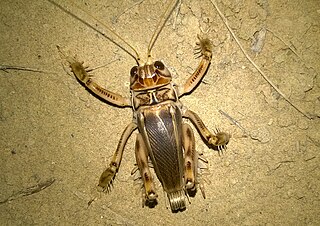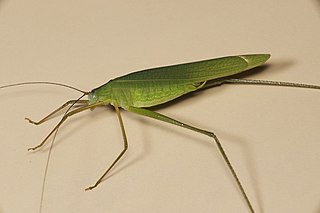
Anostostomatidae is a family of insects in the order Orthoptera, widely distributed in the southern hemisphere. It is named Mimnermidae or Henicidae in some taxonomies, and common names include king crickets in Australia and South Africa, and wētā in New Zealand. Prominent members include the Parktown prawn of South Africa, and the giant wētā of New Zealand. The distribution of this family reflects a common ancestry before the fragmenting of Gondwana.

Schizodactylidae is a family of orthopteran insects found in Asia and southern Africa, known as dune crickets or splay-footed crickets. They are usually found in desert and sandy areas. Species are predatory, including Schizodactylus inexspectatus. T. B. Fletcher notes that one captive individual did not feed on any vegetable matter. Fossils are known since the Early Cretaceous.

Gryllacrididae are a family of non-jumping insects in the suborder Ensifera occurring worldwide, known commonly as leaf-rolling crickets or raspy crickets. The family historically has been broadly defined to include what are presently several other families, such as Stenopelmatidae and Rhaphidophoridae, now considered separate. As presently defined, the family contains two subfamilies: Gryllacridinae and Hyperbaeninae. They are commonly wingless and nocturnal. In the daytime, most species rest in shelters made from folded leaves sewn with silk. Some species use silk to burrow in sand, earth or wood. Raspy crickets evolved the ability to produce silk independently from other insects, but their silk has many convergent features to silkworm silk, being made of long, repetitive proteins with an extended beta-sheet structure.

The Phaneropterinae, the sickle-bearing bush crickets or leaf katydids, are a subfamily of insects within the family Tettigoniidae. Nearly 2,060 species in 85 genera throughout the world are known. They are also known as false katydids or round-headed katydids.

Diestrammena is a 'camel' or 'cave-cricket' genus in the family Rhaphidophoridae. Species in the genus are native to Asia, including Japan.

Gryllacridinae is an Orthopteran subfamily in the family Gryllacrididae.

Larnaca is an Asian genus of Orthopterans, sometimes known as 'leaf-folding crickets', in the subfamily Gryllacridinae and tribe Gryllacridini. Species have been recorded from: southern China, Indochina and western Malesia.

Mogoplistidae is a family of scaly crickets within the superfamily Grylloidea. Considered to be monophyletic, a sister taxon to the Gryllidae crickets. This family consists of more than 370 species worldwide; 20 species in 4 genera occur in North America and this family includes the scaly crickets of Europe.
Capnogryllacris is a genus of leaf-rolling crickets in the subfamily Gryllacridinae and tribe Capnogryllacridini. Species are found in Far East and South Asia, which includes those previously placed in the obsolete genus Borneogryllacris.
Lipotactes is a genus of bush crickets found in southern China, Indo-China and Malesia; it is the only living genus in the subfamily Lipotactinae.
Hemigyrus is an Asian genus of bush-crickets in the tribe Phyllomimini and the subfamily Pseudophyllinae. Species have been recorded from: southern China and Indo-China.

Elimaea is a large genus within Tettigoniidae, the bush cricket or katydid family. Species in this genus are found in India, southern China, Indo-China and Malesia.
Anabropsis is a genus of king crickets in the tribe Anabropsini. They are found tropical areas of the Americas, Africa and Asia.

The Orthopteran subfamily Aemodogryllinae contains about sixteen genera of camel crickets. It was named after AemodogryllusAdelung, 1902 - which is now considered a subgenus of Diestrammena.
Rhaphidophora is the type genus of camel crickets in the tribe Rhaphidophorini.
Stonychophora is a genus of camel crickets in the tribe Rhaphidophorini. Species in this genus can be found from Indo-China and Malesia to New Caledonia.

Gryllacris is a genus of Orthopterans, sometimes known as 'leaf-folding crickets' in the family Gryllacridinae. It is the type genus for the family, tribe Gryllacridini and its subfamily.

Hyperbaeninae is a subfamily of Orthopterans, sometimes known as 'leaf-folding crickets' in the family Gryllacrididae; Hyperbaenus ensifer is the type species. The known distribution includes tropical: central and southern America, Africa and mainland Asia to Australasia.
Neanias is a genus of Orthopterans, sometimes known as 'leaf-folding crickets' in the subfamily Gryllacridinae and tribe Gryllacridini. The recorded distribution is: Indian subcontinent, Japan, Hainan, Indochina, and western Malesia (Sumatra).

Petaloptila is a genus of European crickets in the subfamily Gryllomorphinae and is typical of the tribe Petaloptilini; it was erected by Pantel in 1890. Species are mostly recorded from the European mainland.












